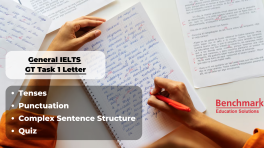Passive Voice Rules for IELTS Grammar Success
- 0 Comments


It’s crucial to master the passive voice in order to maintain a formal tone and contribute to the clarity of your writing. It’s equally important to use the passive voice in the right place and not overuse overuse it.
Table of Contents
1. Passive vs Active Voice
Active voice is generally straightforward and simple to understand. It also places emphasis on the person performing the action, whereas passive voice places emphasis on what the action is being done to (the object of the sentence). The passive voice also has a more formal tone.
Active Structure: Subject + Verb + Object
Passive Structure: Object + Verb + Subject
1.1 When to avoid a passive sentence structure
- To express clear arguments and opinions in the task 2 essay and speaking section.
Example: I believe the government should provide free education to the public.
Avoid: It is believed by me that the government should………….
- To describe personal experiences in the speaking section.
Example: I visit art galleries while I’m travelling abroad.
Avoid: Art galleries are visited by me when I’m travelling abroad.
- To place emphasis on the doer of the action.
Example: The majority of the population agrees that the government isn’t doing enough to fight against climate change.
Avoid: The government isn’t doing enough to fight against climate change, as agreed on by the majority of the population.
2. How to Form a Passive Sentence in Various Tenses
The structure of a passive sentence is: Object + be + past participle
Example: The wrong package was delivered to my house.
An active sentence in any tense can be changed into the passive voice. All you need to do is change the be-verb depending on the tense being used.
Take a look at the following structures and examples of each tense in passive voice:
| Tense | Structure | Example |
|---|---|---|
| Past simple | was/were + past participle | An increase in sales was recorded yesterday. |
| Past perfect | had + been + past participle | An increase in sales had been recorded in 2016. |
| Past continuous | was/were + being + past participle | The number of sales was being recorded over a period of 10 days. |
| Present simple | am/is/are + past participle | The grapes are harvested. |
| Present perfect | has/have + been + past participle | The issue has been discussed with the staff already. |
| Present continuous | am/is/are + being + past participle | The issue is being discussed with the staff as I write this letter. |
| Modals in Simple tenses | may/might/can/could/must/will + be + past participle | In my opinion, these rules must be implemented as soon as possible. |
| Modals in Perfect tenses | could/must + have been + past participle | The project could have been completed earlier if they had received the necessary funding in time. |
3. When to use Passive Voice
Passive voice can be used in both the speaking and writing sections of IELTS. However, it’s probably more common within the writing tasks, especially IELTS task 1 of the academic training.
3.1 Unknown Doer
Make use of the passive voice when the doer is either unknown or irrelevant. .
Let’s take a look at how this can be used in a task 1 letter for the general training exam.
You bought a faulty electrical appliance in your local electronics store. Write a letter to the store manager.
In the letter include the following:
• Explain why you are writing
• Explain what is wrong with your appliance
• Suggest what you would like the store manager to do
It is not necessary to use any addresses.
- Active voice: Someone damaged the microwave I purchased yesterday.
- Passive voice: The microwave I purchased yesterday has been damaged
In this example, it’s not known who damaged the appliance. For this reason, it’s best to use the passive voice.
3.2 Describing Diagrams
When describing diagrams in writing task 1, the emphasis is on the object that the actions are being done to. As you’re describing the steps in a process, you have to use the present simple tense.


Example:
The tea seeds are sown, and plant growth is increased by sun exposure. Once the plant is grown, the tea leaves are picked and placed in baskets.
3.3 Reporting Data and Trends
The emphasis in this writing task 1 should be on the trends and information displayed on the diagram.


Example:
- An increase in visitors to Cardiff has been documented since 2017.
- A decline in visitors to Dublin can be seen from 2015 to 2020.
3.4 Emphasising the Object
To place emphasis on the object of the sentence, you can use the passive voice. This can be used in both task 1 and task 2 of the writing section.
Active voice: Researchers conducted a study to explore the effects of global warming.
Passive voice: A study was conducted to explore the effects of global warming.
The fact that the researchers were the ones to conduct the study is not essential information, but rather that a study was done.







